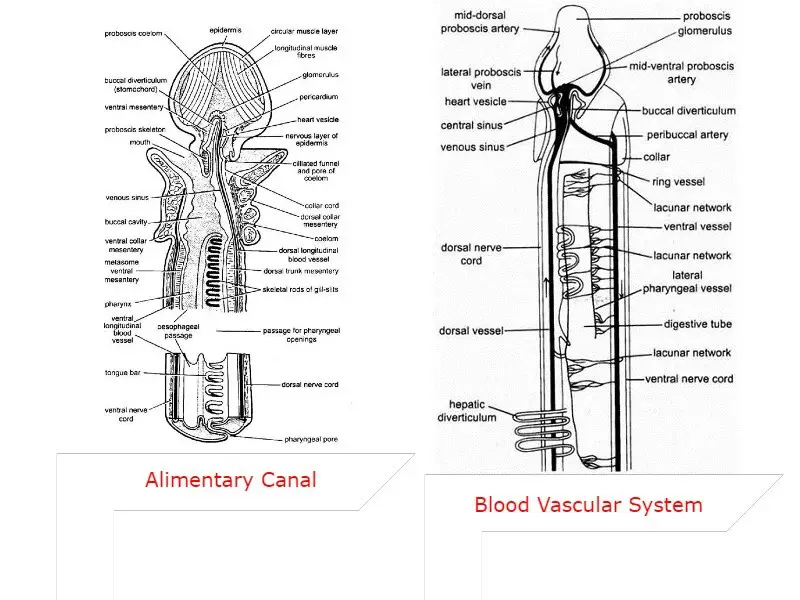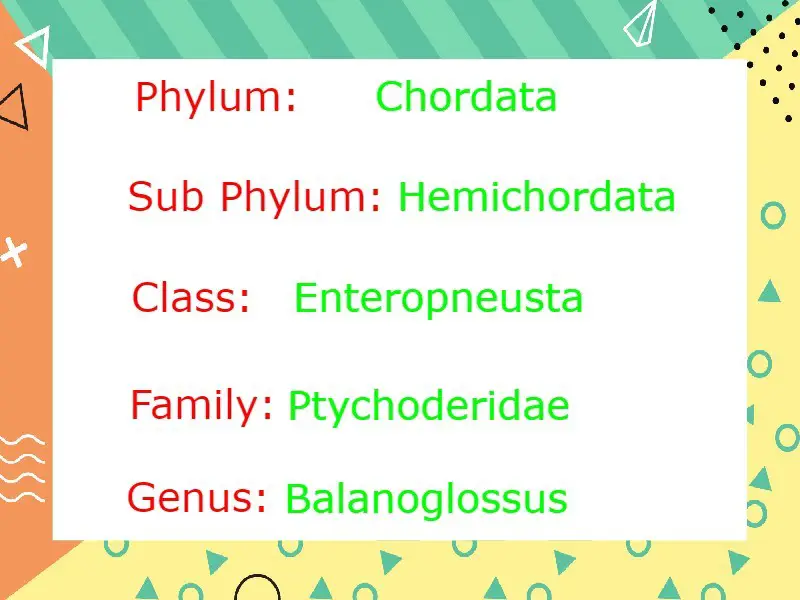Now we will discuss how Balanoglossus collect their food and how their digestion occurs in their alimentary canal. We will focus on every part of their digestive system from mouth to anus.
Table of Contents
Alimentary Canal of Balanoglossus:
Feeding and digestion of the food, everything occurs inside the alimentary canal which starts at the mouth opening and ends at the anus. The alimentary canal is suspended by dorsal mesentery and on the ventral side, the entire alimentary canal is connected to the ventral mesentery.
As alimentary canal in Balanoglossus have two openings mouth and anus so it is the complete digestive system and the alimentary canal is straight tubular in Balanoglossus. The alimentary canal has covered by ciliated epithelium and on the outside, it has a basement membrane but the muscular layer is absent.
The alimentary canal has different regions, mouth, buccal cavity, pharynx, oesophagus, intestine and anus.
Mouth:
The mouth in Balanoglossus is present on the ventral side in the collar region. In the collar region, there is a grove between the collarette and proboscis stalk, in this grove, a circular and wide opening is the mouth opening of Balanoglossus.
Muscule fibres present in the mouth control the opening and closing of the mouth and it does not remain open every time. The radial muscle fibres keep the mouth open and the circular muscle makes the mouth close when it requires to be closed.

The mouth opening leads to the buccal cavity which is situated in the collar region of the Balanoglossus.
Buccal Cavity:
The mouth opens into a cavity, buccal cavity and this portion ends at the collar-trunk septum. The dorsal wall of the buccal cavity make a hollow tubular extension towards the proboscis and previously it was considered as a notochord by most scientists.
This hollow tubular extension of the buccal cavity is now not considered a notochord and it is known as buccal diverticulum at present. The ciliated epithelium of the buccal cavity and goblet cells secret mucous, after collar-trunk septum the buccal cavity opens into the pharynx.
Pharynx:
This portion of the alimentary canal is present in the brachial region of the trunk. The lateral walls of the pharynx make a constriction that divides the lumen of the pharynx into two parts, on the dorsal side respiratory or brachial portion end on ventral side digestive portion. The lateral ridge of the pharynx is known as parabrachial ridges and the wall of parabrachial ridges are made of columnar cells.

The dorsal respiratory part of the pharynx is open outside through two rows of dorsolateral gill slits and this portion take part in respiration. The gill slits are supported by M shaped branchial skeleton and the digestive portion takes part in the digestive of food.
Oesophagus:
The pharynx takes part in the concentration of food and the pharynx open into the short oesophagus. The oesophagus also have the septum division of the oesophagus but it extends up to a short distance and the dorsal part of the oesophagus, the postbranchial canal has glandular, folded epithelium.
The lumen in the posterior region of the oesophagus is narrow and have a deep furrow.
Intestine:
The intestine is present in the hepatic and posthepatic region of the trunk, in the hepatic region, some sacculation is present on the dorsal wall of the intestine. The sacculation is conspicuous from outside of the body wall in the hepatic region which is known as hepatic caeca.
The posthepatic region of the intestine is remain touched with the ventral body wall and the Pygochord is present there. The posthepatic region of the intestine have a dorsolateral ciliated grove, the grove has tall epithelial cells and long cilia.
Anus:
The alimentary canal end at the end of the trunk through a terminal circular aperture, anus, the anus opening is guarded by a sphincter of circular muscle.
Feeding Mechanism of Balanoglossus:
Balanoglossus live in seawater and they live in burrows made in sand or mud, the organic particles and microorganisms present in the seawater is the only source of food and they collect their food in two ways –
- The gill slits have cilia which creates a water current which makes the sea water pass through the mouth opening, the sea water go to buccal cavity from mouth then it reaches at pharynx. From pharynx the water flow into gill slits, from gill slits water pass into gill sac and then exit outside through gill pores. The food particles also reach into mouth and then other parts of digestive system along with this water current, cilia play a very important role in collecting food, they are known as ciliary feeder.
- The proboscis gland secret mucous which trap the food particles and the cilia present on proboscis give directions to the food particles towards the mouth opening.

Near the mouth region, a U shaped ciliary depression, ciliary organ are present which test the quality of food and if any harmful material is found in the flow of water the mouth opening is covered by the ventral part of the collarette. The closed collarette send back the water current and prevent it from entering into the mouth.
Digestion of Food in Balanoglossus:
The food particles digestion occur in the alimentary canal through the secretion of different digestive enzymes secreted from the pharynx and intestine. The digested biomolecules absorbed by the vascular system and the undigested waste materials along with sand goes outside through the anus in the form of casting.
Reference:
Detailed Information on
What is Balanoglossus: A Tongue Worm
External Morphology of Balanoglossus
Hi Everyone!!! Welcome to Imaluop. Imaluop always try to learn some new and he want to share to other people. Here we will try to learn various topics on Science, specially on Biological Sciences.